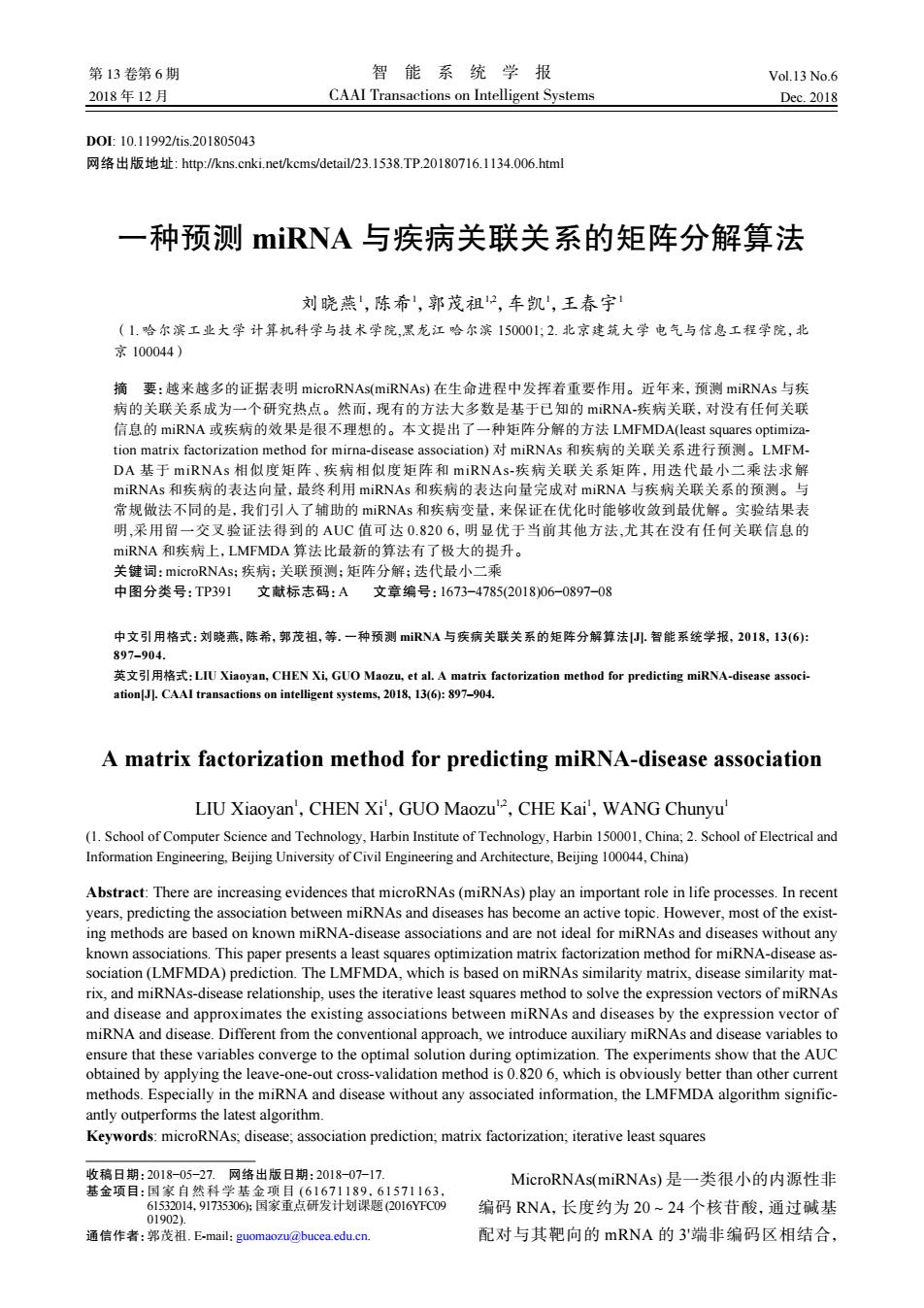正在加载图片...

第13卷第6期 智能系统学报 Vol.13 No.6 2018年12月 CAAI Transactions on Intelligent Systems Dec.2018 D0:10.11992/tis.201805043 网络出版地址:http:/kns.cnki.net/kcms/detail/23.1538.TP.20180716.1134.006html 一种预测niRNA与疾病关联关系的矩阵分解算法 刘晓燕',陈希,郭茂祖2,车凯,王春宇 (1.哈尔滨工业大学计算机科学与技术学院,黑龙江哈尔滨150001;2.北京建筑大学电气与信息工程学院,北 京100044) 摘要:越来越多的证据表明microRNAs((miRNAs)在生命进程中发挥着重要作用。近年来,预测miRNAs与疾 病的关联关系成为一个研究热点。然而.现有的方法大多数是基于已知的RNA-疾病关联,对没有任何关联 信息的miRNA或疾病的效果是很不理想的。本文提出了一种矩阵分解的方法LMFMDA(least squares optimiza- tion matrix factorization method for mirna-disease association)对miRNAs和疾病的关联关系进行预测。LMFM DA基于miRNAs相似度矩阵、疾病相似度矩阵和miRNAs-疾病关联关系矩阵,用迭代最小二乘法求解 miRNAs和疾病的表达向量,最终利用miRNAs和疾病的表达向量完成对miRNA与疾病关联关系的预测。与 常规做法不同的是,我们引入了辅助的niRNAs和疾病变量,来保证在优化时能够收敛到最优解。实验结果表 明,采用留一交叉验证法得到的AUC值可达0.8206,明显优于当前其他方法,尤其在没有任何关联信息的 niRNA和疾病上,LMFMDA算法比最新的算法有了极大的提升。 关键词:microRNAs;:疾病:关联预测;矩阵分解;迭代最小二乘 中图分类号:TP391文献标志码:A 文章编号:1673-4785(2018)06-0897-08 中文引用格式:刘晓燕,陈希,郭茂祖,等.一种预测mRNA与疾病关联关系的矩阵分解算法J.智能系统学报,2018,13(6): 897-904. 英文引用格式:LIU Xiaoyan,CHEN Xi,.GUO Maozu,etal.A matrix factorization method for predicting miRNA-disease associ- ation[JI.CAAI transactions on intelligent systems,2018,13(6):897-904. A matrix factorization method for predicting miRNA-disease association LIU Xiaoyan',CHEN Xi',GUO Maozu'2,CHE Kai',WANG Chunyu' (1.School of Computer Science and Technology,Harbin Institute of Technology,Harbin 150001,China;2.School of Electrical and Information Engineering,Beijing University of Civil Engineering and Architecture,Beijing 100044,China) Abstract:There are increasing evidences that microRNAs(miRNAs)play an important role in life processes.In recent years,predicting the association between miRNAs and diseases has become an active topic.However,most of the exist- ing methods are based on known miRNA-disease associations and are not ideal for miRNAs and diseases without any known associations.This paper presents a least squares optimization matrix factorization method for miRNA-disease as- sociation(LMFMDA)prediction.The LMFMDA,which is based on miRNAs similarity matrix,disease similarity mat- rix,and miRNAs-disease relationship,uses the iterative least squares method to solve the expression vectors of miRNAs and disease and approximates the existing associations between miRNAs and diseases by the expression vector of miRNA and disease.Different from the conventional approach,we introduce auxiliary miRNAs and disease variables to ensure that these variables converge to the optimal solution during optimization.The experiments show that the AUC obtained by applying the leave-one-out cross-validation method is 0.820 6,which is obviously better than other current methods.Especially in the miRNA and disease without any associated information,the LMFMDA algorithm signific- antly outperforms the latest algorithm. Keywords:microRNAs;disease;association prediction;matrix factorization;iterative least squares 收稿日期:2018-05-27.网络出版日期:2018-07-17. MicroRNAs(miRNAs)是一类很小的内源性非 基金项目:国家自然科学基金项目(61671189,61571163 61532014.91735306:国家重点研发计划课题2016YFC09 编码RNA,长度约为20~24个核苷酸,通过碱基 01902). 通信作者:郭茂祖.E-mail:guomaozu@bucea.edu.cn 配对与其靶向的mRNA的3'端非编码区相结合,DOI: 10.11992/tis.201805043 网络出版地址: http://kns.cnki.net/kcms/detail/23.1538.TP.20180716.1134.006.html 一种预测 miRNA 与疾病关联关系的矩阵分解算法 刘晓燕1 ,陈希1 ,郭茂祖1,2,车凯1 ,王春宇1 (1. 哈尔滨工业大学 计算机科学与技术学院,黑龙江 哈尔滨 150001; 2. 北京建筑大学 电气与信息工程学院,北 京 100044) 摘 要:越来越多的证据表明 microRNAs(miRNAs) 在生命进程中发挥着重要作用。近年来,预测 miRNAs 与疾 病的关联关系成为一个研究热点。然而,现有的方法大多数是基于已知的 miRNA-疾病关联,对没有任何关联 信息的 miRNA 或疾病的效果是很不理想的。本文提出了一种矩阵分解的方法 LMFMDA(least squares optimization matrix factorization method for mirna-disease association) 对 miRNAs 和疾病的关联关系进行预测。LMFMDA 基于 miRNAs 相似度矩阵、疾病相似度矩阵和 miRNAs-疾病关联关系矩阵,用迭代最小二乘法求解 miRNAs 和疾病的表达向量,最终利用 miRNAs 和疾病的表达向量完成对 miRNA 与疾病关联关系的预测。与 常规做法不同的是,我们引入了辅助的 miRNAs 和疾病变量,来保证在优化时能够收敛到最优解。实验结果表 明,采用留一交叉验证法得到的 AUC 值可达 0.820 6,明显优于当前其他方法,尤其在没有任何关联信息的 miRNA 和疾病上,LMFMDA 算法比最新的算法有了极大的提升。 关键词:microRNAs;疾病;关联预测;矩阵分解;迭代最小二乘 中图分类号:TP391 文献标志码:A 文章编号:1673−4785(2018)06−0897−08 中文引用格式:刘晓燕, 陈希, 郭茂祖, 等. 一种预测 miRNA 与疾病关联关系的矩阵分解算法[J]. 智能系统学报, 2018, 13(6): 897–904. 英文引用格式:LIU Xiaoyan, CHEN Xi, GUO Maozu, et al. A matrix factorization method for predicting miRNA-disease association[J]. CAAI transactions on intelligent systems, 2018, 13(6): 897–904. A matrix factorization method for predicting miRNA-disease association LIU Xiaoyan1 ,CHEN Xi1 ,GUO Maozu1,2 ,CHE Kai1 ,WANG Chunyu1 (1. School of Computer Science and Technology, Harbin Institute of Technology, Harbin 150001, China; 2. School of Electrical and Information Engineering, Beijing University of Civil Engineering and Architecture, Beijing 100044, China) Abstract: There are increasing evidences that microRNAs (miRNAs) play an important role in life processes. In recent years, predicting the association between miRNAs and diseases has become an active topic. However, most of the existing methods are based on known miRNA-disease associations and are not ideal for miRNAs and diseases without any known associations. This paper presents a least squares optimization matrix factorization method for miRNA-disease association (LMFMDA) prediction. The LMFMDA, which is based on miRNAs similarity matrix, disease similarity matrix, and miRNAs-disease relationship, uses the iterative least squares method to solve the expression vectors of miRNAs and disease and approximates the existing associations between miRNAs and diseases by the expression vector of miRNA and disease. Different from the conventional approach, we introduce auxiliary miRNAs and disease variables to ensure that these variables converge to the optimal solution during optimization. The experiments show that the AUC obtained by applying the leave-one-out cross-validation method is 0.820 6, which is obviously better than other current methods. Especially in the miRNA and disease without any associated information, the LMFMDA algorithm significantly outperforms the latest algorithm. Keywords: microRNAs; disease; association prediction; matrix factorization; iterative least squares MicroRNAs(miRNAs) 是一类很小的内源性非 编码 RNA,长度约为 20~24 个核苷酸,通过碱基 配对与其靶向的 mRNA 的 3'端非编码区相结合, 收稿日期:2018−05−27. 网络出版日期:2018−07−17. 基金项目:国家自然科学基金项 目 (61671189, 61571163, 61532014,91735306);国家重点研发计划课题 (2016YFC09 01902). 通信作者:郭茂祖. E-mail:guomaozu@bucea.edu.cn. 第 13 卷第 6 期 智 能 系 统 学 报 Vol.13 No.6 2018 年 12 月 CAAI Transactions on Intelligent Systems Dec. 2018